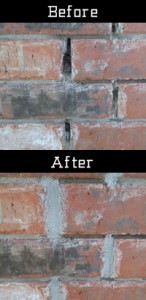Masonry is one of the strongest building materials available; this makes it perfect for structures like chimneys that are constantly exposed to the elements. Unfortunately, the mortar that holds the bricks together may not last as long as the bricks themselves. When this occurs, the mortar may need to be repaired or replaced in order to preserve the structural integrity of the chimney. The tuckpointing process can make your chimney stronger and safer by replacing damaged mortar.
What is tuckpointing?
 Bricks and mortar are used to make up the masonry of your chimney structure. However, these two building materials have different lifespans. While bricks may be able to last 50 years or longer with little to no signs of damage or wear and tear, mortar can often start to break down in as little as 25 years. Because of this, your mortar may need to be replaced long before the bricks do.
Bricks and mortar are used to make up the masonry of your chimney structure. However, these two building materials have different lifespans. While bricks may be able to last 50 years or longer with little to no signs of damage or wear and tear, mortar can often start to break down in as little as 25 years. Because of this, your mortar may need to be replaced long before the bricks do.
While cracked or spalling mortar may not seem like a serious problem, it can cause serious damage to the safety and stability of your chimney. Without strong mortar holding the bricks together, the structural stability of the chimney can be compromised; likewise, damaged mortar makes the surrounding bricks more susceptible to damage from moisture and the elements.
Tuckpointing was developed as a way to repair damaged mortar without affecting or removing the surrounding masonry. During the tuckpoint process, the old or damaged mortar is carefully removed; new mortar is then carefully applied in layers to create solid, durable mortar joints that will last for years to come.
In order to help the repairs blend seamlessly with the rest of your masonry, the mortar for your chimney will be specially mixed to best match the color, texture, and finish of the existing mortar. This helps the repaired areas better blend with the rest of the chimney while maintaining the original aesthetic.
How does mortar get damaged?
There are a number of ways that your mortar can be damaged. Below are four of the most common causes of mortar and masonry damage.
- Age: While both bricks and mortar deteriorate with age, mortar breaks down twice as fast as bricks. Because of this, your mortar may need to be replaced or repaired first.
- Acid rain: Although water can be damaging to your chimney, masonry is simply not built to withstand the acidic condensates of acid rain. It can quickly cause the mortar – and bricks – to crumble and spall.
- Moisture: Water is one of the most damaging forces to the masonry of your chimney; small amounts of absorbed water can freeze, expand, and cause cracks and holes to form throughout the bricks and mortar.
- Settling and shifting: As your home settles, the chimney settles with it. Unfortunately, if it was not built upon a solid foundation the chimney may shift or crack. This strain is often first seen in the more-delicate masonry joints.
Years of exposure to the elements can damage your home’s masonry; repair cracked or spalling mortar using the tuckpointing process to leave your chimney stronger and safer than before. For more information on tuckpointing, contact New Buck Chimney Services today!
